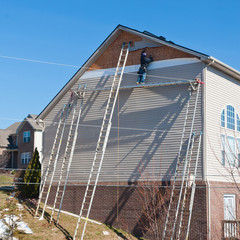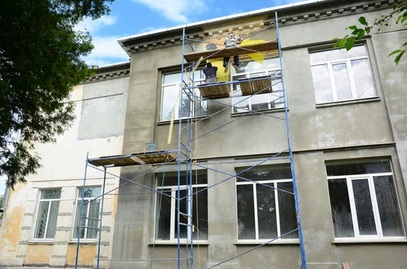Stucco repair is the process of repairing stucco cracks. Moisture intrusion in your home’s exterior wall can lead to mildew, mold, and, eventually, wall rot. Stucco Repair Charleston SC involves thoroughly inspecting your stucco wall system to find any underlying issues. This process usually starts with examining areas around windows.
 A hairline crack is a small surface crack within a wall crafted from stucco. These cracks have the same thickness as a strand of hair and can appear for a number of reasons. One of the most common is that the plaster used to construct the wall wasn’t mixed correctly. Another reason is that the house is settling, and yet another cause is that the exterior surface was painted too soon after the stucco was installed.
A hairline crack is a small surface crack within a wall crafted from stucco. These cracks have the same thickness as a strand of hair and can appear for a number of reasons. One of the most common is that the plaster used to construct the wall wasn’t mixed correctly. Another reason is that the house is settling, and yet another cause is that the exterior surface was painted too soon after the stucco was installed.
When a homeowner notices these cracks, they should be repaired promptly. This is because these cracks allow moisture to penetrate the stucco. This can cause mold, mildew, ugly discoloration of the exterior, and even wall rot that can require costly remediation.
The first step in repairing these small cracks is to pressure wash the entire area. This will ensure a clean surface to which the caulking or spackling will adhere. Applying a layer of acrylic paint over the crack is also a good idea to disguise it.
Once the crack is cleaned, opening it up at least a quarter inch with a cold chisel and hammer is important. This will prevent the crack from becoming a water leak later on. It is also a good idea to gently chisel the edges of the crack so that they are beveled evenly.
Next, the crack should be filled with a caulking product designed for stucco. There are a variety of options on the market, including sanded caulk that’s easy to use and paintable. Quikrete makes a popular brand of this caulking for mortar that can be found at many hardware stores.
If the crack is very deep, a bit of concrete patching mix may be necessary before applying a coat of acrylic caulk. It is important to follow the manufacturer’s instructions when mixing this product. Once it is mixed, a caulking gun can be used to fill the crack. It is a good idea to start at the top of the crack and work your way down, smoothing the caulk with your finger.
Repairing Cracks Less Than a 1/4 Inch
Typically, cracks less than a 1/4 inch deep are easy to repair. You can use a stucco patch from a hardware store for these small holes or surface divots. For a stronger patch, mix a small batch of Portland cement plaster and add coloring pigment to match your existing stucco. Apply the pigmented plaster to a piece of cardboard and let it dry before using it on your exterior wall. Once the patch is dry, apply it to your hole or divot.
Before you begin, make sure that your stucco isn’t deteriorating due to some underlying problem. For example, if the plaster has started to crumble or the lath underneath is rusting, you might need a remediation job instead of a simple repair. A stucco expert can check the integrity of your plaster and help you decide how to proceed.
Moisture penetration is one of the biggest culprits in stucco deterioration. It can enter through cracks, around window and door openings, or behind building paper that is torn or poorly lapped at seams. It may then seep into the studs of your walls, causing mold and mildew, discoloration, and even wall rot. Left untreated, wall rot can cause serious structural damage to your home.
Repairing moisture problems before they get out of control can save you thousands in damages. To do this, you must understand the difference between remediation and repair.
Remediation is an extensive process that fixes the underlying issues that cause deterioration. Remediation includes a thorough inspection of your entire stucco wall system, including the area beneath the damaged areas and any structures attached to your home, such as chimneys or wood siding.
Stucco is a popular material for exterior walls because it provides a stylish appearance and can resist damage from wind, rain, and other elements. It’s important to note, though, that it’s a very porous material that does require proper moisture management to stay in good condition.
You can usually tell if your stucco is in need of a repair if it feels spongey to the touch, or if you tap on it gently with a wooden hammer and hear a hollow sound. You can also try poking a screwdriver into the surface, but it’s best to call in a masonry contractor to determine the extent of your plaster damage.
Repairing Cracks More Than a 1/4 Inch
If your stucco is crumbling or displaying large cracks that span the width of an index finger, it may be time to call in a professional. These larger cracks, as well as loose stucco flakes and sticking windows or doors, indicate that the problem is more severe than a superficial crack and requires remediation.
Unlike repairs, remediation addresses the underlying cause of the deterioration. It can be more expensive, but it is the only method that will prevent the damage from recurring and may save you money in the long run.
Stucco remediation involves replastering the entire exterior wall system and is more extensive than repair, but it solves the underlying issue that’s causing your stucco to deteriorate. A professional can inspect your stucco and determine if the problem is caused by moisture, foundation settlement or other factors. They can then recommend the appropriate solution:
When you’re ready to tackle this job yourself, get a few quotes from area professionals before choosing one. This will help ensure that you’re paying a fair rate and are working with a trustworthy contractor. In addition, it’s always a good idea to compare prices on the materials needed for this project as prices can vary significantly from one retailer to another.
Begin by identifying areas of loose or cracked stucco and removing any that are secure. Loose stucco often bulges and feels spongey to the touch. Tap gently with a wood or acrylic hammer. Weak stucco will sound hollow, while intact stucco will ring back solidly.
Once the loose or cracked stucco is removed, you can expose the metal lath and studs beneath. Check the condition of the studs and sheathing for any damage or rot. If any are rotting, damaged or missing, replace them with new metal lath and sheathing. Nail the new sheathing securely to the studs and joists with heavy-duty nails.
Apply a base coat to the repaired area. You can use a pre-mixed patch that is ready to trowel on or mix conventional stucco repair mix in a wheelbarrow or plastic tray according to the manufacturer’s instructions. Let it dry thoroughly before applying a second coat of base.
Remediation
Stucco is a type of cement-based plaster that is often used as a decorative and protective coating for the exterior of homes. Over time, it can develop damage from exposure to weather and age, but it is possible to fix this with stucco repair. This is typically done by using a combination of Portland cement and sand, although builders sometimes add acrylics or lime to the mix.
The first step of remediation is to perform a thorough inspection of the stucco wall system, looking for any signs of moisture intrusion. This typically includes checking around windows, as this is a common place for moisture to enter the home’s structure. If underlying issues are discovered, the stucco layers are stripped back to the base of the wall so that they can be repaired.
Remediation is a more expensive service than simple repairs, so homeowners will want to use it only when necessary. However, failing to address water intrusion will eventually lead to more serious problems in the future. For example, if water penetrates the stucco, it may also impact the wood framing of your home, causing mold and rot.
A professional masonry contractor or siding company should perform the stucco remediation work to ensure that it is done correctly. They will remove the damaged stucco, and clean the wall systems underneath it. Then, they will repair the underlying structures and apply new layers of stucco to prevent further damage.
If you are concerned about the condition of your stucco, watch out for red flags such as chipping or dark spots near doors or windows. These are typically a sign that the stucco is about to fail and should be repaired by a professional as soon as possible.
Alternatively, you can purchase a pre-mixed stucco patch at most hardware stores. This is a great option if your stucco is in good shape, but you have a small area that needs to be patched. Just be sure to follow the manufacturer’s instructions for proper application. Then, let the patch dry before painting it.


